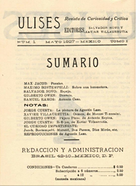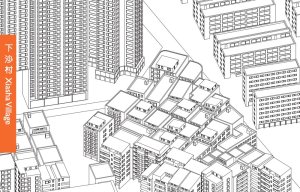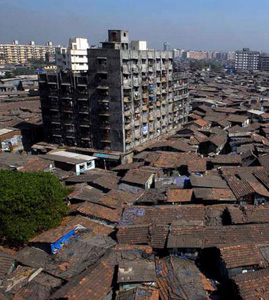Valeria Luiselli ~ Trespassers On The Rooftops: A Secret History Of Mexico City’s Cultural Revolutionaries
 Mexico City rooftops – azoteas – are usually flat. A parapet wall encloses the roof area, creating a kind of open-air patio, less visible to neighbours than the common interior patios of colonial and neocolonial buildings, and not easily accessed by visitors.
Mexico City rooftops – azoteas – are usually flat. A parapet wall encloses the roof area, creating a kind of open-air patio, less visible to neighbours than the common interior patios of colonial and neocolonial buildings, and not easily accessed by visitors.
The rapidly expanding city of the 1920s housed its working classes either in these small rooftop rooms (cuartos de azotea), or in the more well-known vecindades, Mexico’s version of tenement buildings. Brought to Mexico during the conquest in the 16th century, but transformed into the sort of living quarters we know today during the mid-19th century, the vecindades were the typical dwelling space for working-class families, and in them the urban lumpen were crammed into small rooms that surrounded a common patio. While these were occupied by members of the working classes whose jobs did not provide room and board, such as factory workers, builders, or street-vendors, the cuartos de azotea were occupied by maids and servants, usually migrants from the provinces, who worked for the family that lived downstairs.
Read more: http://www.theguardian.com/trespassers-on-the-rooftops
Lammert de Jong ~ De last van de Caribische delen van het Koninkrijk der Nederlanden
Samen met de Caribische delen van het Koninkrijk blijft Nederland werken aan een goede toekomst, aldus de Koning op Prinsjesdag 2015. Wie zou deze veelbelovende doch nietszeggende passage hebben bedacht? Werken aan een goede toekomst vereist veel meer inspanning dan Nederland bereid is in te zetten voor reguliere ondersteuning van de landsdelen. De resolute steun voor rechtshandhaving, ingegeven door een Nederlands belang, steekt schril af tegen de inertie met betrekking tot de ondermaatse kwaliteit van het onderwijs in de landsdelen. Falend onderwijs heeft gevolgen voor burgerschap en de rechtsstaat. Ook op dat terrein zou Nederland moeten werken aan een goede toekomst. Daarentegen worden de Caribische landen door Nederland ervaren als een last, niet als een opdracht. Maar al te graag zou Nederland het tegenwoordig zonder deze gewesten willen doen. In spiegelbeeld geldt dit ook voor de Caribische delen van het Koninkrijk. Over en weer domineert kommer en kwel in plaats van de ambitie er samen het beste van te maken. Koninkrijksrelaties draaien rond de ondersteuning die Nederland de landen biedt, zolang zij daar gebruik van willen maken (Hillebrink). Wie het beter weet, mag het zeggen.
Lees verder: http://www.comitekoninkrijksrelaties.org/de-last-van-de-caribische-delen
Babar Mumtaz ~ How To Make Housing Affordable For The Urban Poor
Cheaper or new building materials don’t go far enough to tackle the housing problem in cities, says Babar Mumtaz.
In countries of the global North, urban ‘affordable housing’ means unaffordable housing subsidised by the state (formerly called social or public housing). But this cannot be the answer where public funds are scarce and are often misused.
So in the South, ‘affordable housing’ has to be what people and society can pay for — but it also has to be housing that is adequate and acceptable.
The question is, why does inadequate housing persist? One reason, of course, is peoples’ low incomes.
In many developing countries, even though over 80 per cent of homes are owner-occupied, low incomes mean that the houses are inadequate — as evidenced by the slums and squatter settlements that have come to define cities in the South.
So the obvious but radical answer could be to pay people a decent wage. Another answer is to revisit the terms and conditions of conventional housing finance: getting a mortgage is off limits for those without high or proven incomes who either cannot borrow, or cannot borrow enough, to buy the cheapest house on the market.
Microfinance can help with repairs or extensions, but has limited application to housing purchase. A non-conventional model for greater reach and impact might, for example, incorporate short-term, sequential loans for incremental construction, paid off with variable amounts (for example, via mobile phones) using a network of community-based retail agents.
But finance aside, what can be done, and why is it not being done?
Read more: http://m.scidev.net/housing-affordable-urban-poor.html
Saskia Sassen ~ Who Owns Our Cities – And Why This Urban Takeover Should Concern Us All
 Does the massive foreign and national corporate buying of urban buildings and land that took off after the 2008 crisis signal an emergent new phase in major cities? From mid-2013 to mid-2014, corporate buying of existing properties exceeded $600bn (£395bn) in the top 100 recipient cities, and$1 trillion a year later – and this figure includes only major acquisitions (eg. a minimum of $5m in the case of New York City).
Does the massive foreign and national corporate buying of urban buildings and land that took off after the 2008 crisis signal an emergent new phase in major cities? From mid-2013 to mid-2014, corporate buying of existing properties exceeded $600bn (£395bn) in the top 100 recipient cities, and$1 trillion a year later – and this figure includes only major acquisitions (eg. a minimum of $5m in the case of New York City).
I want to examine the details of this large corporate investment surge, and why it matters. Cities are the spaces where those without power get to make a history and a culture, thereby making their powerlessness complex. If the current large-scale buying continues, we will lose this type of making that has given our cities their cosmopolitanism.
Indeed, at the current scale of acquisitions, we are seeing a systemic transformation in the pattern of land ownership in cities: one that alters the historic meaning of the city. Such a transformation has deep and significant implications for equity, democracy and rights.
Read more: http://www.theguardian.com/cities/who-owns-our-cities
NosTV Bonaire ~ Ruben Severina ~ “Papiamentu Na Boneiru”
Where Are The World’s Worst Slums?
According to the UN, almost a billion people live in slums, with numbers set to rise in the future. So where are the world’s largest slums?




